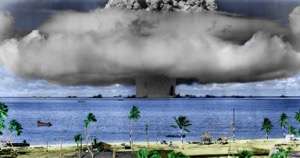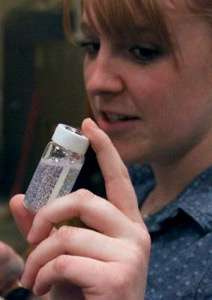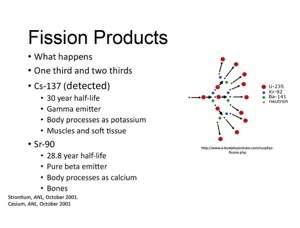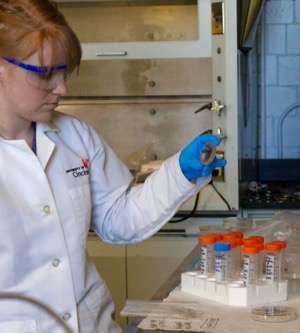Historic nuclear testing on Bikini Atoll may hold clues to long-term impacts on modern urban cities

With increasing international threats of nuclear terror blasts, dirty bombs and the potential for nuclear power-plant accidents, long-term radiation impacts on modern urban cities can be difficult to predict.
For Staci Herman, University of Cincinnati chemistry doctoral student, those answers may come from surprising places.
During "Operation Crossroads" in 1946, the U.S. military tested nuclear weapons in the Marshall Islands Bikini Atoll as part of the 17-year Pacific Proving Grounds Project.
While a string of islands in the Pacific may seem nothing like a major urban city, Herman explains that soil samples from the Marshall Islands and major urban cities have one strong common denominator –– calcium.
According to Herman, the best forensic predictors for how nuclear fallout will affect a major urban city is to compare that city chemically against similar radioactive fallout data. Soil from the Marshall Islands is mostly coral –– a material rich in calcium carbonate and is similar to the cement found in most of the urban city buildings and sidewalks.
"To get the best snapshot for what modern urban long-term radiation fallout might look like, we are looking at well-preserved soil and high-calcium coral samples from a Pacific Island military testing site from the mid-20th century," says Herman. "These samples were collected in 1967, four years after the U.S. military stopped nuclear testing in that region and have been well-preserved, encapsulated in Petri dishes and stored away.

"And since they have not been exposed to weathering, it gives us a unique chemical snapshot of what was present at that time."
The results from Herman's analysis were recently presented at the 251st American Chemical Society National Meeting and Exposition in mid March, in San Diego, titled, "Methods for Analyzing Strontium-90 in High Carbonaceous Samples of Soil from the Marshall Islands."
Herman's research approach is two-fold:
To extrapolate critical radioactive chemical levels from the 50-year-old samples.
To identify the most effective chemical-assay procedures for these kinds of analyses.

BIKINI, BOMBS LEAD TO BUILDING BLOCKS
Herman initially began by developing new chemical-assay procedures to compare with older, more cumbersome methods. In evaluating what procedures work most efficiently for extrapolating radioactive content in high-calcium carbonate materials, she also looks at how weathering may have changed the samples, which will help lead to more efficient forensics analysis in the future.
Aligning with President Santa J. Ono's Creating Our Third Century initiative to increase interdisciplinary research, Herman began using gamma spectroscopy to look at two radionuclides under the guidance of William Connick, UC professor of chemistry, Henry Spitz, UC professor of mechanical engineering, and Sam Glover, UC adjunct faculty of mechanical engineering.
"We already knew that we would start by analyzing for strontium-90 and cesium-137 because we knew we could get our hands on those methods," says Connick. "So once we decided that, the question was how do we find out how much of those important isotopes are present?"
In her initial analysis, Herman identified several different procedures that she will continue to study for their forensics reliability.

"My initial results were very exciting because what I thought was going to happen was nothing like what actually happened," says Herman. "The samples I thought would be high in strontium and low in cesium were all the exact opposite, which completely blew my mind."
On a pragmatic level, Connick says that this radio analytic chemistry research also has a very important nuclear forensics component.
"The challenge here is that we want to be able to decipher the chemical and physical characteristics of a sample so we can determine how the material was made, who made it and when it was made," says Connick. "These characteristics, called signatures, help us trace the material to its origin hoping to prevent any additional release.
"Ultimately, what we're doing here is looking at the materials from what happened 50-years-ago and comparing it to samples collected now, and learning about how a site changes in this particular environment, with this particular type of soil and how that material changes over time."
The next phase of Herman's multi-step research will involve personally traveling to the Marshall Islands in the summer of 2016 to collect current samples from the Bikini Atoll nuclear-testing site.
As part of UC's collaboration with several national Laboratories, Herman will also expand her analysis of the new samples to get a better picture of all of their radionuclides including uranium and plutonium.
As Herman explains, this research is very exciting on many levels, especially for forensics. In addition to documenting the most efficient radioactive chemical-analysis procedures for high calcium-carbonate areas –– cities with a lot of cement –– she looks forward to her research leading to solid predictors for how long and to what extent radioactive materials will affect major urban cities after a catastrophic event.
"And another of my long-term goals is to "fill a knowledge gap" by doing collaborative research with the Lawrence Livermore National Laboratories near San Francisco," claims Herman.
More information: Herman et al. Gamma spectroscopy analysis of archived Marshall Island soil samples, Journal of Radioanalytical and Nuclear Chemistry (2015). DOI: 10.1007/s10967-015-4585-4
George Popescu et al. Compton background suppression with a multi-element scintillation detector using high speed data acquisition and digital signal processing, Journal of Radioanalytical and Nuclear Chemistry (2015). DOI: 10.1007/s10967-015-4355-3
Provided by University of Cincinnati



















